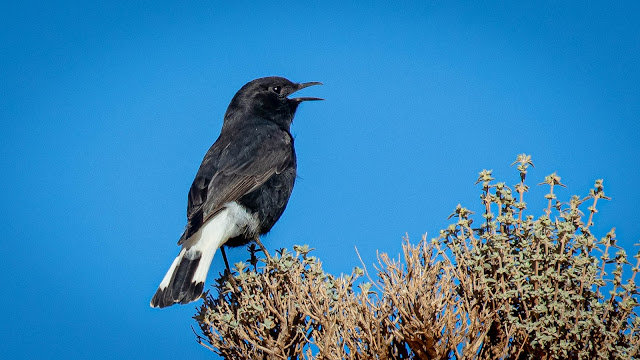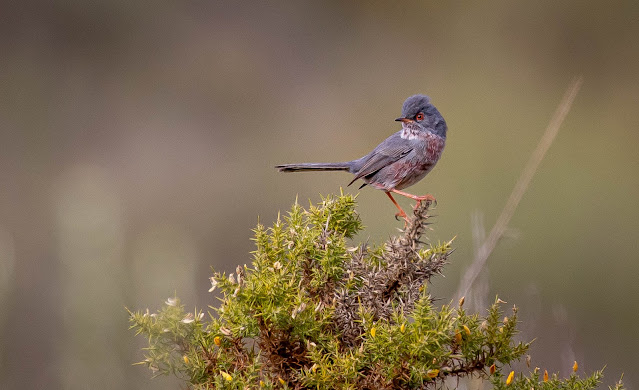Arrived back in Aberdeenshire early this morning (4th November) on the final Ryanair flight of the season from Malaga. Apologies to my reader for the late posting of the final few days in Andalusia.
Since my last post on October 27th, I birded locally from the villa, revisited Guadalhorce and Zapata and also made a return visit to Sierra Loja in Granada province. Unfortunately, this visit proved frustrating as it was a national holiday in Spain, which meant that I had to deal with climbers, cyclists, foragers, and, regrettably, hunters! I knew the risks of birding anywhere in Spain over weekends and holidays, but it was my only day left with favourable weather conditions to get up to the high tops.
 |
| Five Black Wheatears were seen during my visit to Loja |
Suffice it to say I did have some success with (5) Black Wheatears, (3) Black Redstart numerous Thekla Larks and Crested Larks, plus a couple of Rock Sparrows. At higher levels, around 4,000ft there were good numbers of Red-billed Chough.
 |
| Red-billed Chough are quite common at higher levels of the Sierra de Loja. |
One of my main reasons for visiting here in the autumn is the many Ring Ouzels that feed on the hawthorn at higher levels before moving on to their wintering grounds in the mountains of Morocco and Tunisia in north-western Africa. I'm sorry to say that due to the disruption, I didn't come across any birds today, which was disappointing but hardly surprising.
 |
| Ring Ouzel high in Sierra Loja during an autumn visit in 2017 |
As regular readers of my blog will know one of my favourite areas around Mijas, Cantera los Arenales (site details HERE) was devasted last year by huge wildfires and sadly the site remains inaccessible due to forestry work. So as an alternative, I investigated a few habitats around the Coin area which sits on the northern foot of the Sierra de Mijas and came across a good piece of scrubland that appeared to be very productive. Here I enjoyed good views of Dartford Warblers and also encountered several Crested Tits and Sardinian Warblers during my brief walk. I'll certainly be investigating further come the spring.
 |
| Sardinian Warbler while investigating scrubland near Coin |
 |
| Dartford Warbler is always a treat to find. |
At Laguna Grande in Guadalhorce, there was ongoing disruption with lots of digging and scraping, but it was unclear what the plan was. Nonetheless, I am eager to see the outcome when I visit next year. With the disruption, I did spend a little longer in other areas of the reserve, in particular sea-watching at the de Aves Marinas. Despite the generally calm conditions during my visit, it did produce a couple of Arctic Skuas, which came in occasionally to harass groups of Mediterranean Gulls and passing Sandwich Terns.
 |
| Arctic Skua at Guadalhorce. |
During my recent visits to Guadalhorce, I noticed a few Orange Tip butterflies on the wing. Initially, I thought they were the common species I usually encounter each spring so didn't bother investigating them further. Fortunately, John Coakley, one of my birding buddies from Warwickshire, suggested that I take a closer look. To my surprise, it turned out to be a lifer for me! These were in fact Desert Orange Tip butterflies and my thanks to JC for pointing me in the right direction.
 |
| Desert Orange Tip at Guadalhorce |
The Desert Orange Tip is principally a North African species although it has established itself in the extreme south and southeast of Spain in very hot low-altitude habitats where it is however rare and hard to find and of variable abundance from one year to the next.
 |
| Desert Orange Tip ~ A lifer for me at Guadalhorce. |
My final visit to Zapata for this autumn was typical of this wonderful little gem of a habitat with Common Sandpiper, Black-winged Stilt and Green Sandpiper feeding at the ford. Occasionally, a Grey Wagtail would join the birds that are already present here, which include one of three Kingfishers. As the local sheep herd passes through, at least a dozen Cattle Egrets can be seen around. The reedbeds are home to Cettis Warbler, Bluethroat, and Common Waxbills, but I didn't spot any Penduline Tits this year. However, a juvenile Black Stork surprised me when it suddenly dropped into the reeds, my final record for Andalusia Autumn 2023.











